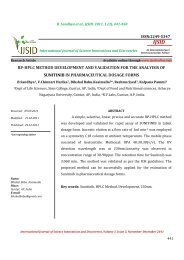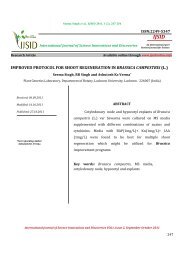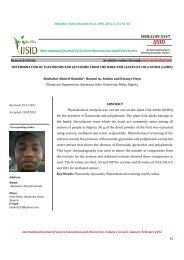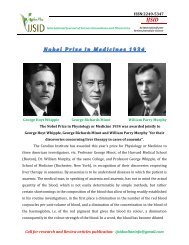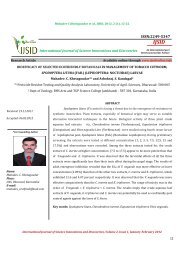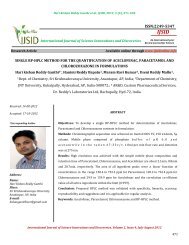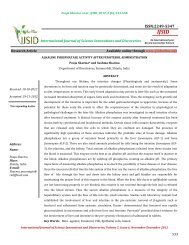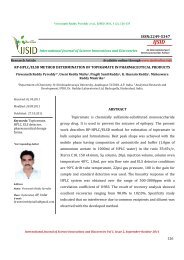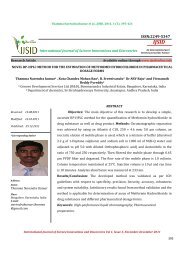identification of antidiabatic activity strychnos nux-vomica roots
identification of antidiabatic activity strychnos nux-vomica roots
identification of antidiabatic activity strychnos nux-vomica roots
You also want an ePaper? Increase the reach of your titles
YUMPU automatically turns print PDFs into web optimized ePapers that Google loves.
S. Tripathi et al., IJSID 2011, 1 (3), 30-33<br />
INTRODUCTION<br />
Strychnos <strong>nux</strong>-<strong>vomica</strong> is a medium-sized tree with a short, crooked, thick trunk, the wood is white hard,<br />
close grained, durable and the root very bitter. Branches irregular, covered with a smooth ash coloured bark;<br />
young shoots deep green, shiny; leaves opposite, short stalked, oval, shiny, smooth on both sides, about 4 inches<br />
long and 3 broad; flowers small, greeny-white, funnel shape, in small terminal cymes, blooming in the cold season<br />
and having a disagreeable smell. Fruit about the size <strong>of</strong> a large apple with a smooth hard rind or shell which when<br />
ripe is a lovely orange colour, filled with a s<strong>of</strong>t white jelly-like pulp containing five seeds covered with a s<strong>of</strong>t<br />
woolly-like substance, white and horny internally. The seeds are removed when ripe, cleansed, dried and sorted;<br />
they are exported from Cochin, Madras and other Indian ports. The seeds have the shape <strong>of</strong> flattened disks densely<br />
covered with closely appressed satiny hairs, radiating from the centre <strong>of</strong> the flattened sides and giving to the seeds<br />
a characteristic sheen; they are very hard, with a dark grey horny endosperm in which the small embryo is<br />
embedded; no odour but a very bitter taste. Nux Vomica contains the alkaloids, Strychnine and Brucine, also traces<br />
<strong>of</strong> strychnicine, and a glucoside Loganin, about 3 per cent fatty matter, caffeotannic acid and a trace <strong>of</strong> copper. The<br />
pulp <strong>of</strong> the fruit contains about 5 per cent <strong>of</strong> loganin together with the alkaloid strychnicine.<br />
Availability<br />
The Strychnine tree (Strychnos <strong>nux</strong>-<strong>vomica</strong> L.) also known as Nux <strong>vomica</strong>, Poison Nut, Semen <strong>strychnos</strong><br />
and Quaker Buttons, is a deciduous tree native to India, southeast Asia, a member <strong>of</strong> family Loganiaceae.<br />
Medicinal Application<br />
The properties<strong>of</strong> Nux Vomica are substantially those <strong>of</strong> the alkaloid Strychnine. The powdered seeds are<br />
employed in atonic dyspepsia. The tincture <strong>of</strong> Nux Vomica is <strong>of</strong>ten used in mixtures - for its stimulant action on the<br />
gastro-intestinal tract. In the mouth it acts as a bitter, increasing appetite; it stimulates peristalsis, in chronic<br />
constipation due to atony <strong>of</strong> the bowel it is <strong>of</strong>ten combined with cascara and other laxatives with good effects.<br />
Strychnine, the chief alkaloid constituent <strong>of</strong> the seeds, also acts as a bitter, increasing the flow <strong>of</strong> gastric juice; it is<br />
rapidly absorbed as it reaches the intestines, after which it exerts its characteristic effects upon the central nervous<br />
system, the movements <strong>of</strong> respiration are deepened and quickened and the heart slowed through excitation <strong>of</strong> the<br />
vagal centre. The senses <strong>of</strong> smell, touch, hearing and vision are rendered more acute, it improves the pulse and<br />
raises blood pressure and is <strong>of</strong> great value as a tonic to the circulatory system in cardiac failure. Strychnine is<br />
excreted very slowly and its action is cumulative in any but small doses; it is much used as a gastric tonic in<br />
dyspepsia. The most direct symptom caused by strychnine is violent convulsions due to a simultaneous stimulation<br />
<strong>of</strong> the motor or sensory ganglia <strong>of</strong> the spinal cord; during the convulsion there is great rise in blood pressure; in<br />
some types <strong>of</strong> chronic lead poisoning it is <strong>of</strong> great value. In cases <strong>of</strong> surgical shock and cardiac failure large doses<br />
are given up to 1/10 grain by hypodermic injection; also used as an antidote in poisoning by chloral or chlor<strong>of</strong>orm.<br />
Brucine closely resembles strychnine in its action, but is slightly less poisonous; it paralyses the peripheral motor<br />
International Journal <strong>of</strong> Science Innovations and Discoveries, Volume 1, Issue 3, November-December 2011<br />
31





